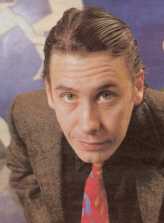Name That Tune

Synopsis
Originally seen in the 1950s as Spot the Tune. The format was first resurrected as a segment for a London-based variety show, hosted by Tom O'Connor. The game was then made a programme in its own right, with O'Connor hosting initially followed later by Lionel Blair. The songs were sung by Maggie Moon.
Each show had two contestants aiming to put their musical knowledge to the test. The rounds (in no particular order) were:
Song and Singer - A round where you just had to write down the songs that were sung, the person getting the most correct winning the round.
Medley - In the studio was a clock which counted thirty seconds. As soon as Maggie started singing, the clock started and as soon as someone buzzed in with an answer, the clock stopped. The person who scored the most points was the winner.
The Roulette Wheel - There was a free-standing wheel which was really two separate concentric wheels sharing the same axis. One wheel had money values around the middle, and the outer wheel had a window which, when passing a certain spot, lit up the word 'DOUBLE!' This was usually accompanied by the audience going 'Ooooohhhhhhhhh, DOUBLE!' for no particular reason. Anyway, when the wheel stopped and the monetary value chosen (doubled if the 'double' was showing - natch), Maggie sung a song. The first person who could guess what it was won the money. Simple as that.
Name that Tune - The round most people remember. The contestants would be given a clue to a song, then would bid as to how many notes they could name it in. "I'll name that tune in four notes", "I'll name that tune in three" etc. Those notes (always from the beginning of a song) would be played on the piano, repeated if necessary, and then the player had to guess. If they got it correct they scored a point and if they were wrong then they gave the point away. It was the best of seven.
The Crown Jools
By today's standards the format would seem quite innocuous, so that's where His Royal Majesty Jools Holland (pictured) comes in. In this reincarnation (that seems to have not been entirely reincarnated), three contestants play in a new, hip studio with a big comfy sofa and some lights. On the plus side, at least Jools Holland and his Big Band has some credibility so maybe it won't be so bad after all.
Each contestant is introduced with a short interview and they are each asked to bring in their favourite record which inevitably no-one has ever heard of. The first part of the game is quite simple, buzz in and guess the tune for ten points (all the tunes in a given batch follow a theme) and if you get it correct you're asked a follow up question for ten points. And for the first part, that's it with the person with the least amount of points getting a T-Shirt and chucked off the show.
After the break, the remaining two play the classic Bidding For Notes game for the rather dubious title of being the Monarch of the Melody. Whoever wins is crowned, given a velvet coat and loses all credibility by winning a Channel 5 game show.
They are given a chance to redeem themselves however by naming a member of his band. Each member hides a prize and, if they can name the tune, then they win the prize. These prizes probably included a plastic kazoo, a piece of cardboard and a turkey drumstick. And that's a good day. And it has to be noted that Jools Holland always seems to look like he'd much rather be doing something else...
Key moments
The almost siren-like "Weee-wahhh-weee-wahhh" noise the roulette wheels used to make.
Trivia
The title drawings in the 90s version were by Jim Moir (that's Vic Reeves to you).
Catchphrases
"Ooooooohhhhh DOUBLE!"
"I'll name that tune in one!"
(Lionel Blair-era): "We hope you'll be driving home tonight in this fabulous car!"
Inventor
Probably based on an American show called $100,000 Name That Tune which offered its contestants $100,000 worth of cash and prizes if they won the final.
Web links
TV Ark's Thames Page has the opening sequence in Realplayer format.


